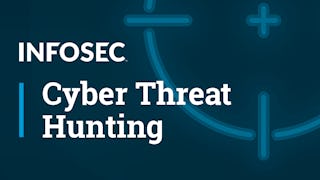Si vous êtes un analyste de cybersécurité de niveau associé qui travaille dans des centres d'opérations de sécurité, ce cours vous aidera à comprendre comment les SOC centrés sur les menaces doivent se préparer à analyser les menaces nouvelles et émergentes en mettant en œuvre des procédures d'investigation de sécurité robustes - A la fin du cours, vous serez en mesure de : - Comprendre les concepts de la chasse aux cybermenaces - Décrire les cinq niveaux de maturité de la chasse (HM0-HM4) - Décrire le cycle de chasse en quatre étapes - Décrire l'utilisation du Common Vulnerability Scoring System (CVSS) et énumérer les métriques de base de CVSS v3.0 - Décrire les composants de notation de CVSS v3.0 (base, temporel et environnemental) - Fournir un exemple de notation de CVSS v3.0 - Décrire l'utilisation d'un tableau de bord des menaces au sein d'un SOC - Fournir des exemples de ressources de sensibilisation aux menaces accessibles au public - Fournir des exemples de sources et de flux de renseignements sur les menaces externes accessibles au public - Décrire l'utilisation des flux de renseignements sur la sécurité - Décrire les systèmes d'analyse des menaces - Décrire les outils de recherche sur la sécurité en ligne - Simuler des actions malveillantes pour alimenter les données d'événements sur les outils Security Onion en vue d'une analyse ultérieure - Identifier les ressources pour la chasse aux cyber-menaces. Pour réussir ce cours, vous devez avoir les connaissances suivantes : 1. des compétences et des connaissances équivalentes à celles acquises dans le cours Implementing and Administering Cisco Solutions (CCNA) v1.0 2. une bonne connaissance d'Ethernet et de TCP/IP. Familiarité avec les réseaux Ethernet et TCP/IP 3. Connaissance pratique des systèmes d'exploitation Windows et Linux 4. Familiarité avec les concepts de base de la sécurité des réseaux.


Enquête sur les menaces
Ce cours fait partie de Spécialisation Principes fondamentaux des opérations de cybersécurité

Instructeur : Cisco Learning & Certifications
4 808 déjà inscrits
Inclus avec
(39 avis)
Compétences que vous acquerrez
- Catégorie : Contrôle continu
- Catégorie : Surveillance du réseau
- Catégorie : Analyse du réseau
- Catégorie : Surveillance des événements
- Catégorie : Évaluations de la vulnérabilité
- Catégorie : Moniteur du système
- Catégorie : Réponse aux incidents
- Catégorie : Détection des menaces
- Catégorie : Gestion de la sécurité
- Catégorie : Gestion des informations et des événements de sécurité (SIEM)
- Catégorie : Chasse aux cybermenaces
- Catégorie : Gestion des menaces
- Catégorie : Cyber Threat Intelligence
Détails à connaître

Ajouter à votre profil LinkedIn
24 devoirs
Découvrez comment les employés des entreprises prestigieuses maîtrisent des compétences recherchées

Élaborez votre expertise du sujet
- Apprenez de nouveaux concepts auprès d'experts du secteur
- Acquérez une compréhension de base d'un sujet ou d'un outil
- Développez des compétences professionnelles avec des projets pratiques
- Obtenez un certificat professionnel partageable

Il y a 4 modules dans ce cours
Si vous êtes un analyste de cybersécurité de niveau associé qui travaille dans des centres d'opérations de sécurité, ce cours vous aidera à comprendre comment les SOC centrés sur les menaces doivent se préparer à analyser les menaces nouvelles et émergentes en mettant en œuvre des procédures d'investigation de sécurité robustes - A la fin du cours, vous serez en mesure de : - Comprendre les concepts de la chasse aux cybermenaces - Décrire les cinq niveaux de maturité de la chasse (HM0-HM4) - Décrire le cycle de chasse en quatre étapes - Décrire l'utilisation du Common Vulnerability Scoring System (CVSS) et énumérer les métriques de base de CVSS v3.0 - Décrire les composants de notation de CVSS v3.0 (base, temporel et environnemental) - Fournir un exemple de notation de CVSS v3.0 - Décrire l'utilisation d'un tableau de bord des menaces au sein d'un SOC - Fournir des exemples de ressources de sensibilisation aux menaces accessibles au public - Fournir des exemples de sources et de flux de renseignements sur les menaces externes accessibles au public - Décrire l'utilisation des flux de renseignements sur la sécurité - Décrire les systèmes d'analyse des menaces - Décrire les outils de recherche sur la sécurité en ligne - Simuler des actions malveillantes pour alimenter les données d'événements sur les outils Security Onion en vue d'une analyse ultérieure - Identifier les ressources pour la chasse aux cyber-menaces. Pour réussir ce cours, vous devez avoir les connaissances suivantes : 1. des compétences et des connaissances équivalentes à celles acquises dans le cours Implementing and Administering Cisco Solutions (CCNA) v1.0 2. une bonne connaissance d'Ethernet et de TCP/IP. Familiarité avec les réseaux Ethernet et TCP/IP 3. Connaissance pratique des systèmes d'exploitation Windows et Linux 4. Familiarité avec les concepts de base de la sécurité des réseaux.
Inclus
13 vidéos22 lectures10 devoirs1 sujet de discussion
Si vous êtes un analyste de cybersécurité de niveau associé qui travaille dans des centres d'opérations de sécurité, ce cours vous aidera à décrire la corrélation et la normalisation des événements. A la fin du cours, vous serez capable de : - Décrire les sources d'événements de surveillance de la sécurité du réseau (IPS, Firewall, NetFlow, Proxy Server, IAM, AV et journaux d'application) - Décrire les preuves directes et indirectes - Décrire la chaîne de possession pour toutes les preuves et interagir avec les forces de l'ordre - Décrire un exemple de normalisation des données de sécurité - Fournir un exemple de corrélation des événements de sécurité - Expliquer les concepts de base de l'agrégation, du résumé et de la déduplication des données de sécurité - Utiliser les applications Security Onion Sguil et ELSA comme plateforme SIEM pour surveiller le réseau à la recherche de particularités et démarrer une enquête. Pour réussir ce cours, vous devez avoir les connaissances suivantes : 1. des compétences et des connaissances équivalentes à celles acquises dans le cours Implementing and Administering Cisco Solutions (CCNA) v1.0 2. une bonne connaissance de l'Ethernet et du TCP/IP. Familiarité avec les réseaux Ethernet et TCP/IP 3. Connaissance pratique des systèmes d'exploitation Windows et Linux 4. Familiarité avec les concepts de base de la sécurité des réseaux.
Inclus
8 vidéos18 lectures6 devoirs
Si vous êtes un analyste de cybersécurité de niveau associé qui travaille dans des centres d'opérations de sécurité, ce cours vous expliquera comment mener des enquêtes sur les incidents de sécurité. A la fin du cours, vous serez capable de : - Expliquer l'objectif de l'enquête sur les incidents de sécurité : Découvrir le qui, le quoi, le quand, le où, le pourquoi et le comment de l'incident - Décrire le cheval de Troie d'accès à distance China Chopper - Identifier le trafic réseau créé par une menace persistante avancée (APT). Pour réussir ce cours, vous devez avoir les connaissances suivantes : 1. des compétences et des connaissances équivalentes à celles acquises dans le cours Implementing and Administering Cisco Solutions (CCNA) v1.0 2. une bonne connaissance d'Ethernet et de TCP/IP. Familiarité avec les réseaux Ethernet et TCP/IP 3. Connaissance pratique des systèmes d'exploitation Windows et Linux 4. Familiarité avec les concepts de base de la sécurité des réseaux.
Inclus
4 vidéos11 lectures3 devoirs
Si vous êtes un analyste de cybersécurité de niveau associé qui travaille dans des centres d'opérations de sécurité, ce cours vous aidera à comprendre comment utiliser un modèle de livre de jeu pour organiser la surveillance de la sécurité. A la fin du cours, vous serez capable de : - Décrire le processus d'analyse de la sécurité - Décrire l'utilisation d'un playbook dans un SOC - Décrire les composants d'un playbook dans un SOC typique - Décrire l'utilisation d'un système de gestion de playbook dans le SOC - Explorer les playbooks du SOC. Pour réussir ce cours, vous devez avoir les connaissances suivantes : 1. des compétences et des connaissances équivalentes à celles acquises dans le cours Implementing and Administering Cisco Solutions (CCNA) v1.0 2. une bonne connaissance d'Ethernet et de TCP/IP. Familiarité avec les réseaux Ethernet et TCP/IP 3. Connaissance pratique des systèmes d'exploitation Windows et Linux 4. Familiarité avec les concepts de base de la sécurité des réseaux.
Inclus
6 vidéos12 lectures5 devoirs
Obtenez un certificat professionnel
Ajoutez ce titre à votre profil LinkedIn, à votre curriculum vitae ou à votre CV. Partagez-le sur les médias sociaux et dans votre évaluation des performances.
Instructeur

Offert par
En savoir plus sur Sécurité
 Statut : Essai gratuit
Statut : Essai gratuitCisco Learning and Certifications
 Statut : Prévisualisation
Statut : Prévisualisation
Infosec
 Statut : Essai gratuit
Statut : Essai gratuitCisco Learning and Certifications
Pour quelles raisons les étudiants sur Coursera nous choisissent-ils pour leur carrière ?




Avis des étudiants
39 avis
- 5 stars
89,74 %
- 4 stars
7,69 %
- 3 stars
0 %
- 2 stars
0 %
- 1 star
2,56 %
Affichage de 3 sur 39
Révisé le 4 juin 2024
Very interesting formation that will help me to go further into Cyber Security field well done, that was worth it !
Révisé le 20 mai 2023
This course provided me with all i need to know to learn more about cybersecurity. Coursera is not just an online institution but a home of knowledge.

Ouvrez de nouvelles portes avec Coursera Plus
Accès illimité à 10,000+ cours de niveau international, projets pratiques et programmes de certification prêts à l'emploi - tous inclus dans votre abonnement.
Faites progresser votre carrière avec un diplôme en ligne
Obtenez un diplôme auprès d’universités de renommée mondiale - 100 % en ligne
Rejoignez plus de 3 400 entreprises mondiales qui ont choisi Coursera pour les affaires
Améliorez les compétences de vos employés pour exceller dans l’économie numérique
Foire Aux Questions
Pour accéder aux supports de cours, aux devoirs et pour obtenir un certificat, vous devez acheter l'expérience de certificat lorsque vous vous inscrivez à un cours. Vous pouvez essayer un essai gratuit ou demander une aide financière. Le cours peut proposer l'option "Cours complet, pas de certificat". Cette option vous permet de consulter tous les supports de cours, de soumettre les évaluations requises et d'obtenir une note finale. Cela signifie également que vous ne pourrez pas acheter un certificat d'expérience.
Lorsque vous vous inscrivez au cours, vous avez accès à tous les cours de la spécialisation et vous obtenez un certificat lorsque vous terminez le travail. Votre certificat électronique sera ajouté à votre page Réalisations - de là, vous pouvez imprimer votre certificat ou l'ajouter à votre profil LinkedIn.
Oui, pour certains programmes de formation, vous pouvez demander une aide financière ou une bourse si vous n'avez pas les moyens de payer les frais d'inscription. Si une aide financière ou une bourse est disponible pour votre programme de formation, vous trouverez un lien de demande sur la page de description.
Plus de questions
Aide financière disponible,

